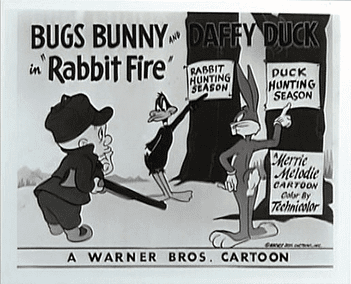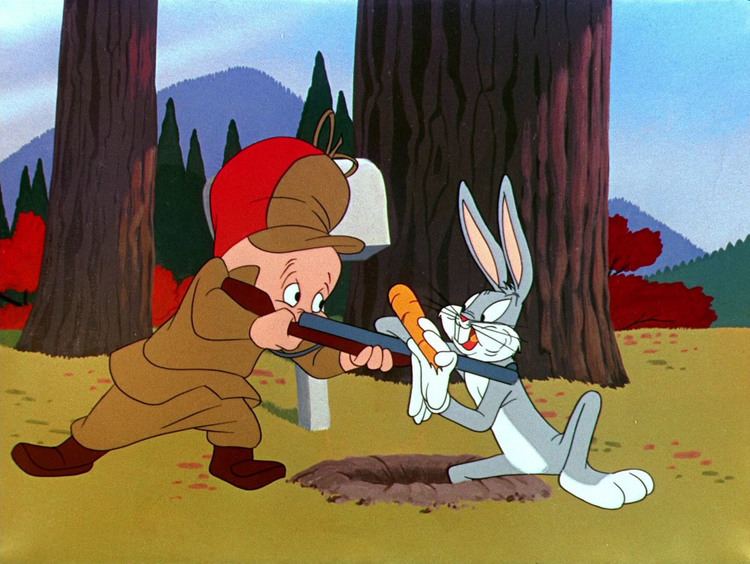Rabbit Fire
6 /10 1 Votes
Film series Jones "hunting trilogy" Producer Edward Selzer Language English | Music director Carl Stalling Duration | |||||||||||||||||||||||||||||||||
 | ||||||||||||||||||||||||||||||||||
Release date May 19, 1951 (USA) Similar movies Related Chuck Jones movies | ||||||||||||||||||||||||||||||||||
8 mile official trailer 1 2002 hd
Rabbit Fire is a 1951 Looney Tunes (reissued as a 1960 Blue Ribbon Merrie Melodies) cartoon starring Bugs Bunny, Daffy Duck, and Elmer Fudd. Directed by Chuck Jones and written by Michael Maltese, the short is notable for being the first film in Jones' "hunting trilogy"—the other two films being Rabbit Seasoning and Duck! Rabbit, Duck!. It is also the first film to feature a feud between Bugs and Daffy. Produced by Edward Selzer for Warner Bros. Cartoons, Inc., the short was released to theaters on May 19, 1951 by Warner Bros. Pictures and is widely considered among Jones' best and most important films.
Contents
- 8 mile official trailer 1 2002 hd
- Act of valor 2012 official trailer hd movie navy seals
- Plot
- Voice actors
- Reaction
- Production details
- Credits
- Availability
- References

The film marks a significant shift in Daffy's personality, going from being the insane "screwball" character who (like Bugs) overwhelmed his adversaries, to being a much more flawed individual, full of greed and vanity, and desiring for attention under the spotlight. This personality change, which was previously explored by Jones in You Were Never Duckier and Daffy Dilly, and even earlier in Friz Freleng's You Ought to Be in Pictures, was done in order for Daffy to better serve as Bugs' foil. This was fueled by Bugs' popularity surpassing Daffy's quickly over the years, increasing the desire of the studio's animators to pair the two together.

Act of valor 2012 official trailer hd movie navy seals
Plot

Daffy Duck lures Elmer Fudd to Bugs Bunny's burrow, and watches from aside when Elmer attempts to shoot Bugs. But Bugs informs Elmer that it isn't rabbit season, but instead duck season. Daffy emerges, irate, and attempts to convince Elmer that Bugs is lying. Their conversation breaks down into Bugs leading Daffy to admit it is duck season by a number of verbal plays.
Once Daffy admits it is duck season, Elmer fires his shotgun at Daffy, causing the duck to suffer a temporary setback before he tries again. This repeats multiple times during the short, with Daffy trying different ploys to get Elmer to shoot Bugs, but Bugs continues to outwit him. After Daffy is shot for the third time, he walks away. Elmer tries to shoot him, but no more shells come out of his gun. Thrilled, Daffy comes back and grabs Elmer's gun to make sure, only to be shot with the last shell.
Daffy then sees a sign that Bugs has nailed to a tree saying "Duck Season Open". As he sees Elmer approaching, he disguises himself as Bugs, telling him that it's duck season. Bugs then appears disguised as Daffy, complete with webbed feet and fake bill, and asks Daffy why he thinks it's duck season. Daffy points at the tree where he previously saw the "Duck Season Open" sign. However, the sign nailed to that tree now reads "Rabbit Season Open", implying that Bugs replaced the signs. Elmer, of course, shoots Daffy. After Daffy gets blasted, he goes up to Bugs and says, "You're desthpicable!" The two walk away, getting out of their costumes as Daffy rants to Bugs how despicable he is. Ignoring Daffy, Bugs then begins to read duck recipes from a cookbook that he pulls out of his rabbit hole, and Daffy does the same with a rabbit recipe cookbook that he also pulls from the rabbit hole (though why Bugs is disturbingly keeping a rabbit recipe book in his own home is unknown and goes unquestioned). Elmer tells them he's a vegetarian and only hunts for the sport of it (although, in previous episodes, it has been stated that he was hunting Bugs for rabbit stew or the like). Outraged, Bugs gets in Elmer's face and claims, "Oh, yeah? Well, there's other sports besides huntin', ya know!" Daffy then offers to play tennis ("Anyone for tennis?"). Elmer blasts him again, tells Bugs that he's next, and then begins shooting and chases both of them all the way to the rabbit hole. Bugs comes out of his hole and accuses Elmer of "hunting rabbits with an elephant gun," suggesting Elmer to shoot an Elephant instead. Just as Elmer is considering it, a huge elephant appears from literally nowhere, threatens Elmer in a Joe Besser voice ("You do and I'll give you such a pinch!"), and preemptively pounds him into the ground before striding off.
Elmer finally loses patience and decides to take out both Bugs and Daffy. Daffy comes into the scene, disguised as a hunting dog and Bugs comes in as a lady hunter. It appears that the outrage of Elmer hunting for sport rather than food has united both rabbit and duck against him. Elmer, however, sees through their disguise and threatens to shoot them. The cartoon climaxes when Bugs and Daffy argue by a tree with a sign that starts with the words "Rabbit Season." Bugs and Daffy continue to pull off the sign to alternatively reveal it is "Duck Season" or "Rabbit Season" until they hit a final sign, proclaiming it to be "Elmer Season." The tables turned, Elmer starts running and Bugs and Daffy, dressed as hunters, begin to stalk Elmer.
Voice actors
Reaction
Rabbit Fire is generally considered among Chuck Jones and Michael Maltese's best works, and is noted for its use of dialogue gags in lieu of the physical gags more typical in animation. Besides the two sequels to this film, a number of other notable Jones shorts, including Beanstalk Bunny and Ali Baba Bunny, paired quick-witted Bugs and self-serving Daffy with (or rather against) each other.
The "duck season/rabbit season" argument from this short became one of the most notable references of the Looney Tunes franchise, and has been analyzed both by scholars and by Jones himself (though it should be noted that this gag was actually used by Daffy against Porky six years earlier in the cartoon Duck Soup to Nuts). According to an essay by Darragh O'Donoghue, Rabbit Fire "stands in close relation to human experience, striving and generally failing to grasp an elusive quarry or goal." Richard Thompson said that in the film, there is "the clearest definition of character roles: Elmer never knows what's going on; Bugs always knows what's going on and is in control of things; Daffy is bright enough to understand how to be in control, but never quite makes it." Jones himself refers to Rabbit Fire as a "corner" picture, among his works that, "as in turning a corner in a strange city, reveal new and enchanting vistas."
The short earned an honorable mention for animation historian Jerry Beck's list of The Fifty Greatest Cartoons: As Selected by 1000 Animation Professionals. Its 1952 sequel, Rabbit Seasoning, made the actual list at number 30. The style, setup, and plot of Rabbit Fire were adapted into the opening sequence of Warner Bros.' 2003 film Looney Tunes: Back in Action.
The non sequitur elephant character based on Joe Besser was the inspiration for Horatio the Elephant, a recurring character on PBS' Sesame Street.
The Elephant from The Major Lied 'Til Dawn reappeared, but redesigned.
Production details
Credits
Availability
This cartoon is available on the Looney Tunes Golden Collection: Volume 1, Disc 2.
